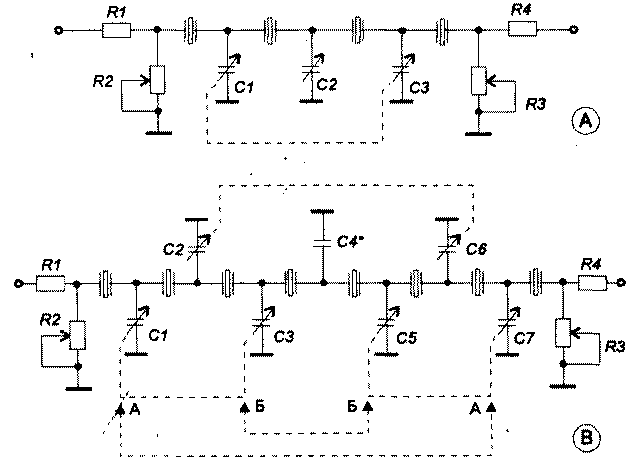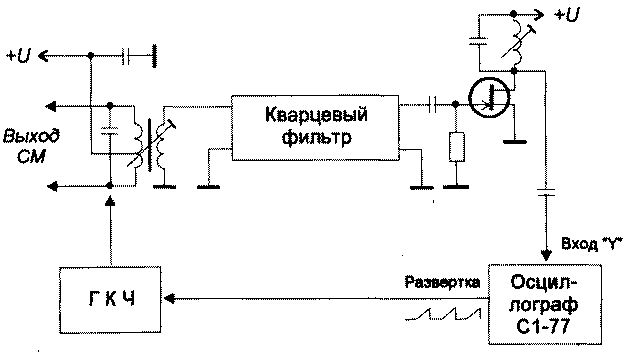
|
|
ENCYCLOPEDIA OF RADIO ELECTRONICS AND ELECTRICAL ENGINEERING Adjustment of quartz filters. Encyclopedia of radio electronics and electrical engineering
Encyclopedia of radio electronics and electrical engineering / Knots of amateur radio equipment. Quartz filters In amateur radio literature [1, 2, 3], several methods were given for tuning quartz filters. All of them are approximately the same and come down to preliminary prototyping in order to measure the parameters of quartz and a rather large amount of cumbersome mathematical calculations. However, after editing, the resulting frequency response (AFC) of the filter, as a rule, is very far from the desired one. Obviously, the scatter of the parameters of the filter elements and the installation capacities that are difficult to take into account affects. As a result, a lot of time has to be spent on frequency response correction by selecting filter capacitances and terminating resistors. Based on the foregoing, the idea arose to abandon the calculations altogether. Since their results are imperfect, and instead of prototyping, we confine ourselves to checking the performance of, in fact, quartz resonators (for this, a simple generator on a single transistor and an oscilloscope is enough), and setting the main filter parameters using variable capacitors (CPB).
Arrows AA and BB show the second option for switching on KPI. Resistors R1, R4 (0 ... 300 Ohm) are installed in the presence of large emissions in the frequency response. Capacitor C4 * is selected in the range from 0 to 30 pF. In order to minimize the number of capacitors, filter circuits containing only parallel capacitances were chosen, Fig.1. Since the filters are symmetrical (with respect to their input-output), it turned out to be possible to use dual KPIs from broadcast receivers with a capacitance of 12 - 495 pF. In addition, you will need one more, pre-calibrated in pF, single-section variable capacitor. The filter setting comes down to the following For tuning, you may need a device for measuring the amplitude-frequency characteristics X1-38 or similar. I use an oscilloscope and a homemade prefix (see below). Initially, all capacitors are set to a position corresponding to a capacitance of 30 ... 50 pF. By controlling the frequency response of the filter on the screen of the device, by rotating the capacitors within small limits, we achieve the required bandwidth. Then, by adjusting the variable resistors (use only non-inductive ones, for example, SP4-1) at the input and output of the filter, we try to equalize the top of the frequency response. The above operations are repeated several times until the desired frequency response is obtained. Further, instead of each individual section of the KPI, we solder a pre-calibrated capacitor, with which we try to optimize the frequency response of the filter. On its scale, we determine the capacitance of a constant capacitor and make a replacement. Thus, all sections of the KPI, in turn, are replaced by capacitors of constant capacitance. We do the same with variable resistors, which we will later replace with constant ones. The final "finishing" of the filter is made directly in place, for example, in the transceiver. After installing the filter in the transceiver, it may be necessary to correct the values of these resistors, while for optimal matching of the filter with the mixer output and the IF input, the GKCH and the oscilloscope must be connected according to the diagram shown in Fig. 2.
Several filters were made according to the described method. I would like to note the following. Setting up three or four crystal filters with some skill takes no more than an hour, but with 8 crystal filters the time is much higher. At the same time, attempts to pre-configure first two separate 4-crystal filters, and then dock them - turned out to be fruitless. The slightest scatter of their parameters (and this always takes place) leads to a distortion of the resulting frequency response. It is also interesting to note that theoretically equal capacitances (for example, C1=C3, in Fig. 1a; C1=C7; C3=C5, in Fig. 1b) after tuning with a graduated KPI according to the optimal frequency response had a noticeable spread. In my opinion, the advantage of this technique is its visibility. On the screen of the device, you can clearly see how the frequency response of the filter changes depending on the change in the capacitance of each capacitor. For example, it turned out that in some cases it is quite enough to change the capacitance of one capacitor (with the help of a relay) in order to change the filter bandwidth without much deterioration in its squareness. As noted above, an S1-77 oscilloscope and a converted prefix for measuring the frequency response are used to adjust the filter [4]. Why C1-77? The fact is that on its side wall there is a connector on which there is a sawtooth voltage of the sweep generator. This allows you to simplify the attachment itself and exclude the sawtooth voltage generator (SPG) from its circuit. Therefore, there is no need for additional synchronization and it becomes possible to observe a stable frequency response at various sweep times. Obviously, other types of oscilloscopes can be adapted, maybe with a little refinement. Since the simplified prefix is used only when working with quartz filters near the frequency of 8 MHz, all other subbands were excluded from it. Also, in the used set-top box, you will need to slightly increase the output voltage. To do this, it is enough to convert the output stage into a resonant one. It must be tuned to resonance every time a new filter is connected to its output. The scheme of the modified attachment is shown in Fig. 3. Due to the introduced "parasitic" capacitances, all connections between the filter under study and the attachment should be made with short conductors, no more than 10 cm long.
Literature 1. V. Zalnerauskas. A series of articles "Quartz filters" Magazine "Radio" No. 1, 2, 6 1982, No. 5, 7 1983 Author: F. Sharapov, RA4PC, Leninogorsk; Publication: N. Bolshakov, rf.atnn.ru
Machine for thinning flowers in gardens
02.05.2024 Advanced Infrared Microscope
02.05.2024 Air trap for insects
01.05.2024
▪ Texas Instruments releases library for MSP430 and CC1100/CC2500 ▪ New high precision low power accelerometers
▪ site section Electric meters. Article selection ▪ article upside down. Popular expression ▪ article What oath did the lords of ancient Chersonese take? Detailed answer ▪ article Portable smokehouse. Tourist tips ▪ article Automatic surge protector. Encyclopedia of radio electronics and electrical engineering
Comments on the article: Sergei May26w27 Thank you!
Home page | Library | Articles | Website map | Site Reviews www.diagram.com.ua |






 Arabic
Arabic Bengali
Bengali Chinese
Chinese English
English French
French German
German Hebrew
Hebrew Hindi
Hindi Italian
Italian Japanese
Japanese Korean
Korean Malay
Malay Polish
Polish Portuguese
Portuguese Spanish
Spanish Turkish
Turkish Ukrainian
Ukrainian Vietnamese
Vietnamese



 Leave your comment on this article:
Leave your comment on this article: